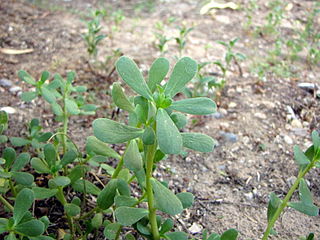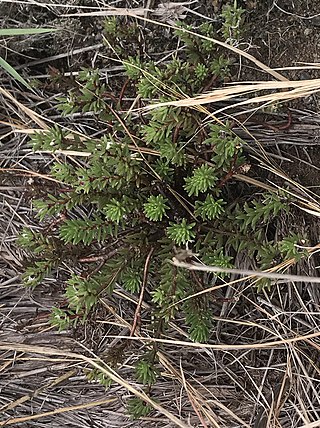
Euphorbia is a very large and diverse genus of flowering plants, commonly called spurge, in the family Euphorbiaceae. "Euphorbia" is sometimes used in ordinary English to collectively refer to all members of Euphorbiaceae, not just to members of the genus.

Crassulacean acid metabolism, also known as CAM photosynthesis, is a carbon fixation pathway that evolved in some plants as an adaptation to arid conditions that allows a plant to photosynthesize during the day, but only exchange gases at night. In a plant using full CAM, the stomata in the leaves remain shut during the day to reduce evapotranspiration, but they open at night to collect carbon dioxide and allow it to diffuse into the mesophyll cells. The CO2 is stored as four-carbon malic acid in vacuoles at night, and then in the daytime, the malate is transported to chloroplasts where it is converted back to CO2, which is then used during photosynthesis. The pre-collected CO2 is concentrated around the enzyme RuBisCO, increasing photosynthetic efficiency. This mechanism of acid metabolism was first discovered in plants of the family Crassulaceae.

Portulaca oleracea is an annual succulent in the family Portulacaceae.

Portulaca is the type genus of the flowering plant family Portulacaceae, with over 100 species, found in the tropics and warm temperate regions. They are known as the purslanes.

The Portulacaceae are a family of flowering plants, comprising 115 species in a single genus Portulaca. Formerly some 20 genera with about 500 species, were placed there, but it is now restricted to encompass only one genus, the other genera being placed elsewhere. The family has been recognised by most taxonomists, and is also known as the purslane family. It has a cosmopolitan distribution, with the highest diversity in semiarid regions of the Southern Hemisphere in Africa, Australia, and South America, but with a few species also extending north into Arctic regions. The family is very similar to the Caryophyllaceae, differing in the calyx, which has only two sepals.

Calandrinia is a large genus of flowering plants known as purslanes and redmaids. It includes over 100 species of annual and perennial herbs which bear colorful flowers in shades of red to purple and white. Plants of this genus are native to Australia, western South America, Central America, and western North America. Some species have been introduced to parts of New Zealand, southern Africa, Asia, and Europe.
Purslane is a common name for several mostly unrelated plants with edible leaves and may refer to:

Portulaca grandiflora is a succulent flowering plant in the family Portulacaceae, native to southern Brazil, Argentina, and Uruguay and often cultivated in gardens. It has many common names, including rose moss, eleven o'clock, Mexican rose, moss rose, sun rose, rock rose, and moss-rose purslane.

Talinum paniculatum is a succulent subshrub in the family Talinaceae that is native to much of North and South America, and the Caribbean countries. It is commonly known as fameflower, Jewels-of-Opar, or pink baby's-breath.

Portulaca sedifolia is a species of flowering plant in the purslane family, Portulacaceae, that is endemic to Yemen. Its natural habitat is rocky areas.

Sesuvium portulacastrum is a sprawling perennial herb in the family Aizoaceae that grows in coastal and mangrove areas throughout much of the world. It grows in sandy clay, coastal limestone and sandstone, tidal flats and salt marshes, throughout much of the world. It is native to Africa, Asia, Australia, Hawai`i, North America and South America, and has naturalised in many places where it is not indigenous.

Portulaca pilosa is a species of flowering succulent plant in the purslane family, Portulacaceae, that is native to the Americas. Its common names include pink purslane, kiss-me-quick and hairy pigweed. Its range extends from the southern United States and the Caribbean as far south as Brazil. It is a succulent with linear leaves and pink flowers.

Portulaca sclerocarpa is a rare species of flowering plant in the purslane family known by the common names 'ihi makole and po`e. It is endemic to Hawaii, where it is known only from the island of Hawaii and an islet off of Lanai. Ten occurrences exist for a total of over 1000 individuals. It is a federally listed endangered species of the United States.

Portulaca suffrutescens, the shrubby purslane, is a plant species native to the southwestern United States and northern and central Mexico. It has been found in Arizona, New Mexico, Texas, Sonora, Chihuahua, Sinaloa, Durango, Querétaro and Guerrero.

Portulaca molokiniensis, known also as 'ihi, is a succulent plant endemic to Hawaii. This plant is federally listed as an endangered species. It has small yellow flowers and when grown from seed may produce a caudex. This plant is easy to propagate.

Portulaca oleracea subsp. sativa also known as golden purslane is one of few subspecies of Portulaca oleracea.

Portulaca amilis, known as Paraguayan purslane, is a species of Portulaca native to South America. It was introduced to the southeastern United States and other countries around the world and can be found in sandy soil in disturbed areas, roadsides, fields, lawns and gardens.

Portulaca lutea, the native yellow purslane, is a species of Portulaca that is indigenous to all of the main islands of Hawaii except for Kaua'i and is widespread throughout the Pacific Islands.
Portulaca minuta, the tiny purslane, is a species of flowering plant. It grows in the Florida Keys and Bahamas.

Portulaca quadrifida, known as pusley, wild purslane, chicken weed, single‑flowered purslane, small‑leaved purslane and 10 o'clock plant, is a species of flowering plant in the genus Portulaca, possibly native to Africa, but certainly widespread over the Old World Tropics, and introduced elsewhere. It is collected in the wild and eaten in salads or cooked, and is a favorite fodder for chickens and pigs.

















